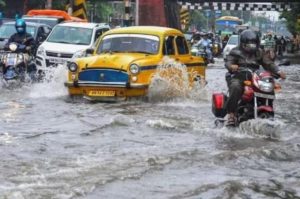Jodhpur Park Wettest Zone Kolkata — In a season defined by erratic monsoon patterns, one Kolkata neighborhood has emerged as an unexpected anomaly: Jodhpur Park. Over the past week, it has recorded significantly higher rainfall than surrounding areas, prompting meteorologists, civic engineers, and environmentalists to examine why this affluent, leafy locality has become the wettest zone in the city.

According to data released by the India Meteorological Department (IMD) and corroborated by the Kolkata Municipal Corporation (KMC) rain gauges, Jodhpur Park received over 158 mm of rainfall in just 24 hours on July 7, compared to 130 mm in Alipore, 110 mm in Salt Lake, and 125 mm in Behala.
Monsoon Rainfall Data Snapshot (July 7–8, 2025)
| Area | Rainfall (24 hrs) |
|---|---|
| Jodhpur Park | 158 mm |
| Alipore | 130 mm |
| Dum Dum | 116 mm |
| Tollygunge | 124 mm |
| Salt Lake | 110 mm |
| Behala | 125 mm |
This localized rainfall spike has taken both citizens and scientists by surprise.
What’s Causing the Excess Rainfall in Jodhpur Park?
Experts have identified five key factors that might be contributing to this anomaly:
1. Topography and Microclimate
According to Dr. A.K. Bhattacharya, climatologist at Jadavpur University:
“Jodhpur Park is slightly lower in elevation than its neighboring zones, and the surrounding green canopy may be influencing air circulation. Microclimates can create isolated zones of intense rain.”
Microclimates are localized atmospheric zones where weather conditions differ from surrounding areas. In cities, tree cover, water bodies, and urban heat island effects can all influence these zones.
2. Urban Heat Island (UHI) Reversal Effect
Interestingly, Jodhpur Park may be cooler than its neighboring concrete-heavy areas, allowing it to attract more condensation and rainfall.
“The thick tree coverage and gardens reduce surface temperatures, encouraging cloud accumulation and precipitation,” says IMD scientist Ritu Roy.
3. Drainage and Water Retention
While not directly influencing rainfall, the inability to drain water efficiently may be giving the impression of more rain. Clogged or aging stormwater lines are likely causing rainwater to accumulate faster and linger longer.
Civic Response and Waterlogging Crisis
Though Jodhpur Park is a planned, upscale locality, it hasn’t been spared the wrath of heavy monsoon downpours.
- Residents have complained of basement flooding, with many ground-floor flats partially submerged.
- The KMC deployed mobile dewatering pumps, but could not resolve the situation for nearly 18 hours.
- Power cuts were reported in at least seven housing blocks due to water entering local transformers.
“This is the third year in a row we’ve seen such flooding. We’re not in a low-lying basin, so why this is happening baffles us,” said Rina Banerjee, a local residents’ welfare association head.
Jodhpur Park Wettest Zone Kolkata: Expert Panel Formed by KMC
KMC Commissioner Binod Kumar announced that a five-member expert committee—comprising meteorologists, hydrologists, engineers, and environmental planners—has been tasked to investigate:
- Rainfall anomaly patterns using satellite data
- Drainage and runoff flow
- Impact of real estate development and unplanned construction
- Role of stormwater canals and wetlands
This committee is expected to release an interim report within 10 days.
Urbanization and Rain Retention: A Hidden Crisis?
Environmentalists argue that rapid urbanization in the area might be disrupting natural rainwater dispersal. Over the past 15 years, Jodhpur Park and adjacent areas like Lake Gardens and Dhakuria have seen:
- Multi-storeyed apartment complexes replacing single-storey bungalows
- Cemented driveways and garden plots reducing permeable surfaces
- Blocked stormwater channels, many of which have vanished due to illegal construction
“The soil can’t breathe anymore. If there’s no place for rainwater to seep in, it stays on the surface,” says Sujata Ghosh, hydrologist and green activist.
Citizen Reactions and Photos Go Viral
The downpour and subsequent flooding led to a social media storm, with residents sharing:
- Videos of water entering drawing rooms
- Children wading through water to school
- Cars stranded in knee-deep water
Hashtags like #JodhpurParkFloods, #KolkataRainCrisis, and #UrbanRainTrap trended locally on Twitter.
Schools, Businesses Disrupted
At least four schools in the locality remained shut for two days due to inaccessibility. Several tuition centers and small clinics in the area faced infrastructure damage.
- St. Mary’s and Jodhpur Park High School both reported flooding of classrooms.
- Clinics had to postpone patient appointments due to equipment damage.
Climate Change and Urban Storm Resilience
This hyper-local flood event has also reignited discussions on climate adaptation for Indian cities.
The IPCC AR6 report already warned that urban centers like Kolkata would face frequent, localized extreme weather events—including short, sharp bursts of rainfall.
Dr. Shibaprasad Dey, a UN climate resilience advisor, says:
“City planners must wake up. You can’t build like it’s 1980 when you’re living in 2025. Rainwater must be channeled or it will drown your city one neighborhood at a time.”
Recommendations Under Review
The KMC and State Urban Development Department are considering:
- Smart rainwater harvesting in all new constructions
- Digitization of drainage maps
- Reintroduction of percolation zones in parks and fields
- Real-time rain radar updates to alert localities of intense microbursts
External Resources
- IMD Kolkata Rainfall Updates
- Kolkata Municipal Corporation
- National Institute of Urban Affairs – Rain Management
- India Meteorological Department – City Forecasts
Final Thoughts
The case of Jodhpur Park becoming the wettest zone in Kolkata this monsoon season is a warning siren. As rainfall patterns become more erratic and intense, city infrastructure, planning, and awareness must evolve.
Kolkata, a city of history and heritage, must not become a victim of its outdated systems. With proper planning, investment, and participation from both authorities and citizens, neighborhoods like Jodhpur Park can transform from floodplains into models of urban climate resilience.
Also read: Home | Channel 6 Network – Latest News, Breaking Updates: Politics, Business, Tech & More

